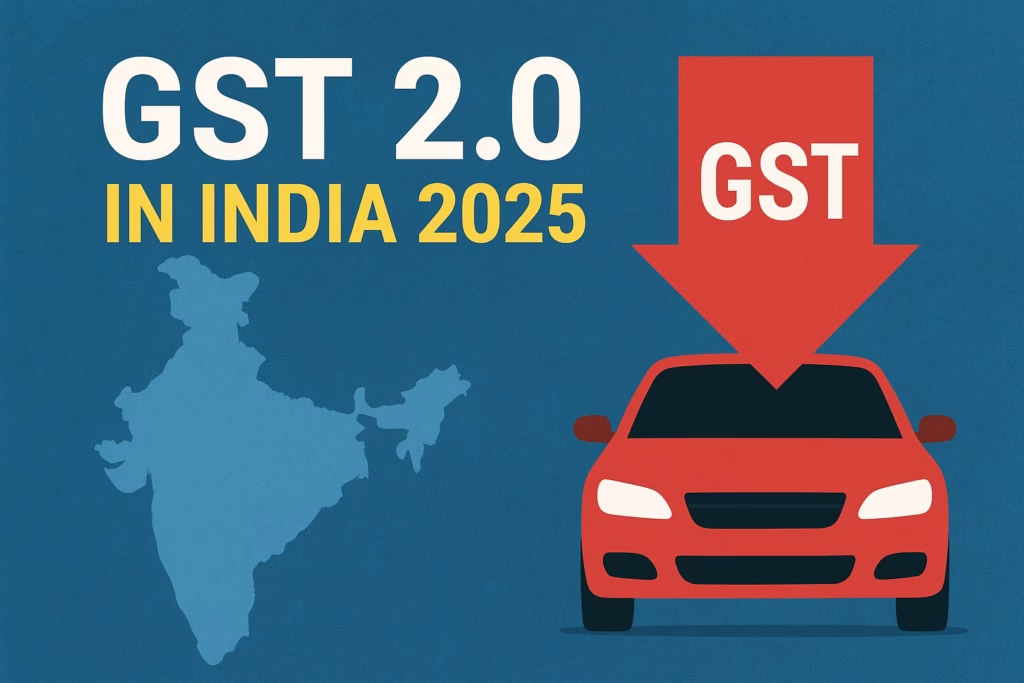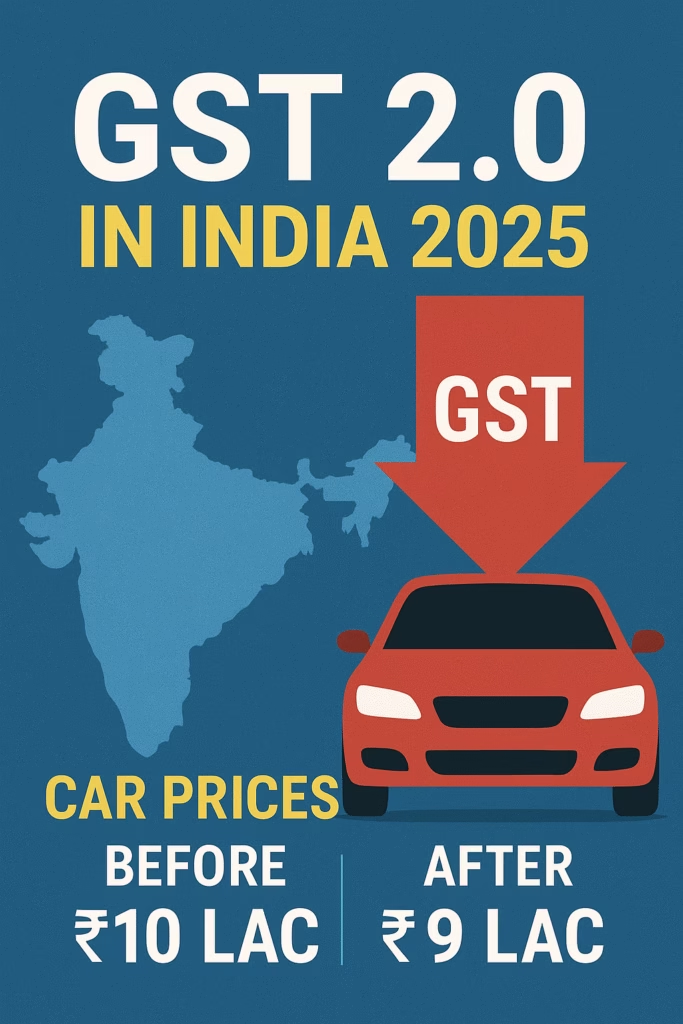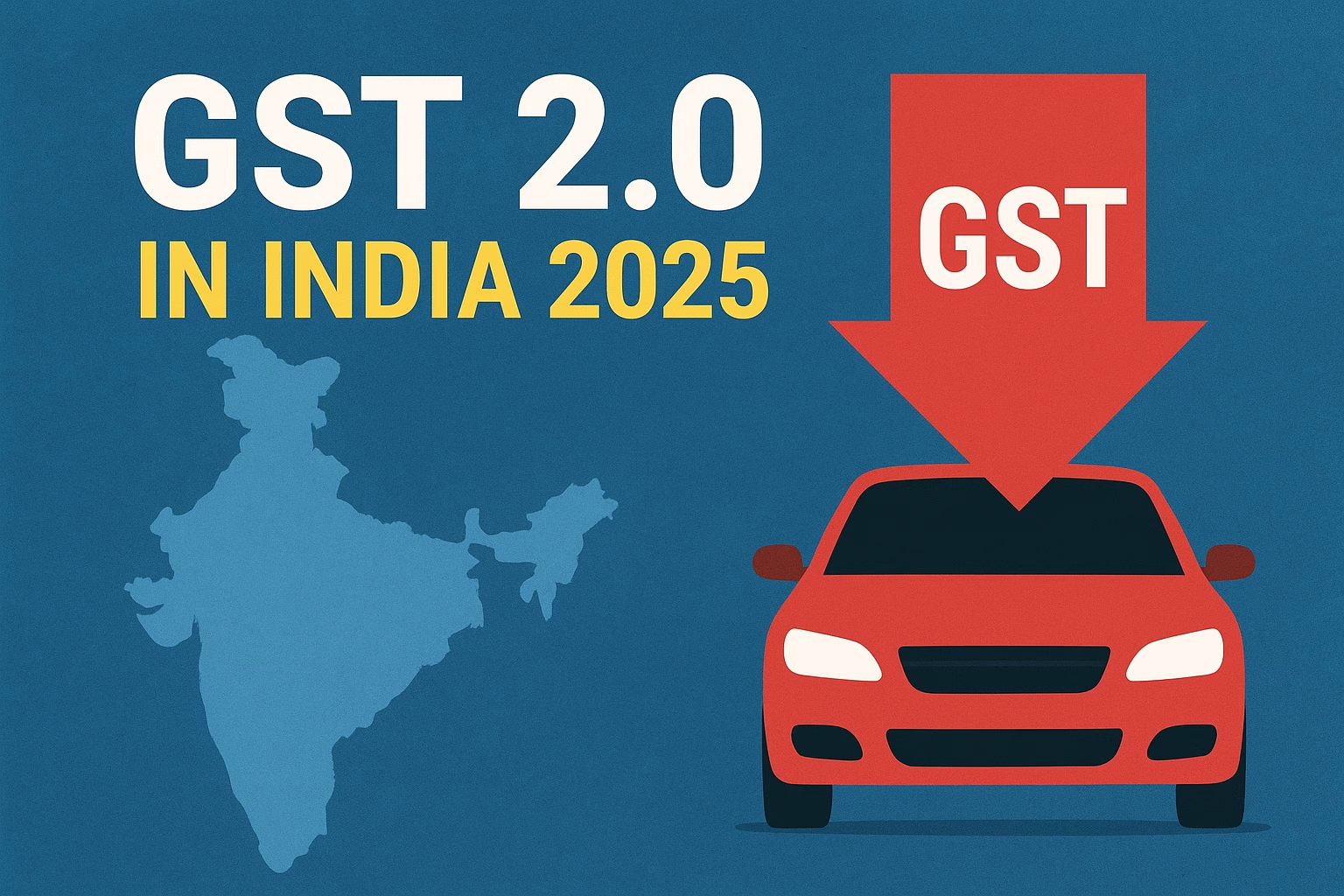The Goods and Services Tax (GST) was one of the most significant tax reforms in India’s history when it was launched in 2017. Fast forward to 2025, the government has now introduced GST 2.0, a more simplified and consumer-friendly version of the tax system. This reform is being called a “next-gen GST”, designed to make compliance easier for businesses and to reduce the tax burden on common citizens.

In this article, we’ll break down:
If you are wondering how GST 2.0 in India 2025 will affect your daily life, business operations, or even big purchases like cars and electronics, this guide will give you all the answers.
What is GST 2.0 in India 2025?
GST 2.0 is the upgraded version of the Goods and Services Tax, announced in September 2025 by the Finance Ministry of India. The key idea behind this reform is to:
- Simplify compliance for small and medium businesses
- Reduce tax rates in high-burden sectors (like automobiles and housing)
- Boost consumer spending by lowering indirect taxes
- Increase government efficiency with AI-powered GST tracking
Unlike the original GST rollout in 2017, which faced initial resistance due to its complexity, GST 2.0 aims to strike a balance between ease of business and affordability for consumers.
Key Changes Introduced in GST 2.0
Here’s a breakdown of the major reforms under GST 2.0 in India 2025:
1. Reduced GST Slabs
- The old system had 5 tax slabs (0%, 5%, 12%, 18%, 28% + cess).
- Under GST 2.0, this has been streamlined into 3 main slabs – 5%, 12%, and 18%.
- Luxury goods and sin products (tobacco, alcohol) remain in the 28% bracket, but cess has been reduced in many categories.
2. Automobile Tax Cut
- One of the biggest highlights is the reduction of GST on cars.
- Small cars, sedans, and SUVs have all received tax cuts, making them cheaper for buyers.
- Electric Vehicles (EVs) have the lowest GST rate at just 3%, encouraging eco-friendly adoption.
3. Simplified Input Tax Credit (ITC)
- Businesses now get real-time ITC matching through an AI-driven GST portal.
- This reduces fraud and speeds up refunds, a major pain point in GST 1.0.
4. Digital-First GST Compliance
- GST 2.0 introduces a single-click filing system using UPI and AI.
- Small businesses with turnover under ₹5 crore can opt for quarterly filing, cutting compliance hassle.
5. GST Council 2.0 – Faster Decision Making
- The restructured GST Council now includes AI-based tax data projections, helping states and the center reach quicker decisions on rate revisions.
Impact of GST 2.0 on Different Sectors
The introduction of GST 2.0 in India 2025 has wide-ranging effects across industries. Let’s look at sector-wise impacts:
1. Automobiles
- Biggest beneficiary of GST 2.0.
- Cars, SUVs, and EVs see price drops from ₹50,000 to ₹12 lakh depending on the model.
- This has triggered a rise in car bookings during the festive season.
2. FMCG (Fast-Moving Consumer Goods)
- Daily-use items like soaps, detergents, packaged food now fall under 12% slab instead of 18%.
- Consumers benefit from reduced prices on essentials.
3. Real Estate & Housing
- Affordable housing GST reduced to 5%, making homes cheaper for first-time buyers.
- Luxury real estate continues to attract higher taxes but with reduced cess.
4. E-commerce & Startups
- Online sellers benefit from simpler compliance and real-time ITC.
- GST on online services like OTT platforms, food delivery, and gaming apps reduced from 18% to 12%.
5. Services Sector
- Restaurants and small service providers under ₹1.5 crore turnover enjoy lower tax rates.
- Professional services like consultancy, design, and IT exports see smoother refunds.

How GST 2.0 Benefits Consumers
For the average Indian consumer, GST 2.0 in India 2025 means:
- Lower car prices – Mass-market hatchbacks, sedans, and SUVs are now more affordable.
- Cheaper essentials – Household goods and groceries have reduced tax rates.
- Boost in housing affordability – Lower GST on under-construction homes.
- EV adoption push – Electric scooters, bikes, and cars are now within middle-class reach.
In short, GST 2.0 directly reduces the cost of living and promotes aspirational purchases.
How GST 2.0 Benefits Businesses
For entrepreneurs, startups, and MSMEs, GST 2.0 brings major relief:
- Quarterly filing option reduces compliance cost.
- AI-powered ITC matching prevents revenue leakage.
- Lower tax rates on essentials boost sales volume in FMCG and retail.
- Exporters benefit from faster refund settlements, improving cash flow.
Overall, GST 2.0 is seen as business-friendly and growth-oriented.
Challenges with GST 2.0
While the reform looks promising, there are some hurdles:
- States may lose some revenue due to reduced tax collections.
- Implementation of AI-powered GST filing will require digital literacy in rural areas.
- Luxury segments (high-end cars, branded items) may still feel overtaxed.
The government is expected to roll out incentive packages for states and training programs for businesses to overcome these challenges.
RELATED:Explained: Why India’s Free Power Scheme 2025 Could Reshape State Elections
Expert Insights on GST 2.0 in India 2025
- Economists believe GST 2.0 could add 0.5% to India’s GDP in the next fiscal year.
- Automobile industry experts see a 20–25% rise in car sales in the next 6 months.
- Startups welcome the simplified tax regime, predicting lower compliance costs and smoother scaling.
Future Roadmap of GST in India
The government has indicated that GST 2.0 is just the beginning. Future goals include:
- Introducing AI-driven predictive tax models
- Linking GST with Direct Tax reforms
- Offering zero-GST slabs for essential items like medicines and education services
- Moving towards a unified tax structure with 2 slabs only in the next decade
Conclusion
The rollout of GST 2.0 in India 2025 marks a major turning point in the country’s tax history. By simplifying compliance, cutting rates for high-demand sectors, and boosting affordability, the government has created a win-win situation for both consumers and businesses.
If you are planning to buy a car, invest in real estate, or expand your startup, GST 2.0 in India 2025 is designed to make your journey smoother and more cost-effective.
The reform is not just about taxes – it’s about empowering India’s growth story in the years to come.

